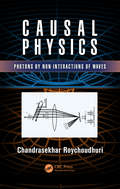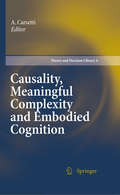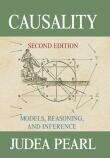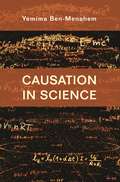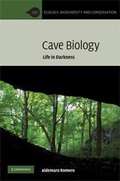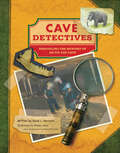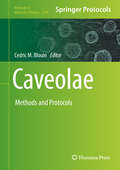- Table View
- List View
Causal Physics: Photons by Non-Interactions of Waves
by Chandrasekhar RoychoudhuriCausal Physics: Photons by Non Interactions of Waves redefines the mathematical Superposition Principle as an operational Superposition Effect; which is the measurable physical transformation experienced by a detector due to stimulations induced by multiple waves simultaneously acting on the detecting dipoles. This light-matter interaction process driven model emerges naturally by incorporating the observed properties, Non-Interaction of Waves (NIW) and quantized photo detectors needing to fill up their "quantum-cups" with the required quantity of energy from all the stimulating waves around it. By not incorporating this NIW-property explicitly, quantum mechanics failed to extract various embedded realities in the theory while incorporated unnecessary hypotheses like wave-particle duality. The book utilizes this NIW-property to explain all the major optical phenomena (diffraction, spectrometry, coherence.) without using any self-contradictory hypotheses that are prevalent now. The book redefines the old ether (constituting the space) as a stationary Complex Tension Field (CTF), holding all the energy of the universe (no need for Dark Energy of Dark Matter). CTF sustains perpetually propagating EM waves as its linear excitations and the particles as self-looped localized resonant non-linear excitations. Tensions are identified by Maxwell, then the velocities of emitting and detecting atoms through the CTF contribute to the Doppler shifts separately. This calls for re-visiting physical processes behind Hubble Redshift and hence Expanding Universe. The success of the book derives from a novel thinking strategy of visualizing the invisible interaction processes, named as Interaction Process Mapping Epistemology (IPM-E). This is over and above the prevailing strategy of Measurable Data Modeling Epistemology (MDM-E). The approach inspires the next generation of physicists to recognizing that the "foundation of the edifice of physics" has not yet been finalized. IPM-E will stimulate more of us to become technology innovators by learning to emulate the ontologically real physical processes in nature and become more evolution congruent. Critical thinkers without expertise in optical science and engineering, will appreciate the value of the content by reading the book backward, starting from Ch.12; which explains the critical thinking methodology besides giving a very brief summary of the contents in the previous chapters. Establishes that abandoning the wave-particle-duality actually allows us to extract more realities out of quantum mechanics. Illustrates how the discovery of the NIW-property profoundly impacts several branches of fundamental physics, including Doppler effect and hence the cosmological red shift Summarizes that many ad hoc hypotheses from physics can be removed, a la Occam’s razor, while improving the reality and comprehension of some of the current working theories Demonstrates that our persistent attempts to restore causality in physical theories will be guided by our capability to visualize the invisible light matter interaction processes that are behind the emergence of all measurable data Draws close attention to the invisible but ontological interaction processes behind various optical phenomena so we can emulate them more efficiently and knowledgably in spite of limitations of our theories Designed as a reference book for general physics and philosophy, this optical science and engineering book is an ideal resource for optical engineers, physicists, and those working with modern optical equipment and high precision instrumentation.
Causal Pluralism in the Life Sciences: A Journey Along the Frontiers of Conceptual Plurality (History, Philosophy and Theory of the Life Sciences #25)
by Kolja EhrensteinThis book takes a new approach to the debate on causal pluralism in the philosophy of biology by asking how useful pluralism is instead of debating its truth. The core thesis in this work is that many problems do not hinge on the question of whether or not we subscribe to causal pluralism. As one step in this central argument, the author develops an account that reasonably distinguishes pluralism from monism; in another step he studies cases that allegedly motivate causal pluralism in biology. Examining these cases shows how pluralism is often irrelevant and why pursuing pluralism is sometimes dangerous, since it may generate pseudo solutions to persistent philosophical problems. This book offers a systematic approach to this subject matter and argues that we might have overestimated the significance of the monism-pluralism distinction and at the same time failed to see the risks of pursuing causal pluralism.
Causal Reasoning in Physics
by Mathias FrischMuch has been written on the role of causal notions and causal reasoning in the so-called 'special sciences' and in common sense. But does causal reasoning also play a role in physics? Mathias Frisch argues that, contrary to what influential philosophical arguments purport to show, the answer is yes. Time-asymmetric causal structures are as integral a part of the representational toolkit of physics as a theory's dynamical equations. Frisch develops his argument partly through a critique of anti-causal arguments and partly through a detailed examination of actual examples of causal notions in physics, including causal principles invoked in linear response theory and in representations of radiation phenomena. Offering a new perspective on the nature of scientific theories and causal reasoning, this book will be of interest to professional philosophers, graduate students, and anyone interested in the role of causal thinking in science.
Causality and Modern Science: Third Revised Edition
by Mario Bunge"I regard it as a truly seminal work in this field." -- Professor William A. Wallace, author of Causality and Scientific ExplanationThis third edition of a distinguished book on the subject of causality is clear evidence that this principle continues to be an important area of philosophic enquiry.Non-technical and clearly written, this book focuses on the ontological problem of causality, with specific emphasis on the place of the causal principle in modern science. The author first defines the terminology employed and describes various formulations on the causal principle. He then examines the two primary critiques of causality, the empiricist and the romantic, as a prelude to the detailed explanation of the actual assertions of causal determination. Finally, Dr. Bunge analyzes the function of the causal principle in science, touching on such subjects as scientific law, scientific explanation, and scientific prediction. Included, also, is an appendix that offers specific replies to questions and criticisms raised upon the publication of the first edition.Now professor of philosophy and head of the Foundation and Philosophy of Science Unit at McGill University in Montreal, Dr. Mario Bunge has formerly been a full professor of theoretical physics. His observations on causality are of great interest to both scientists and humanists, as well as the general scientific and philosophic reader.
Causality for Artificial Intelligence: From a Philosophical Perspective
by Jordi VallverdúHow can we teach machine learning to identify causal patterns in data? This book explores the very notion of “causality”, identifying from a naturalistic and evolutionary perspective how living systems deal with causal relationships. At the same time, using this knowledge to identify the best ways to apply such biological models in machine learning scenarios. One of the more fundamental challenges for AI experts is to design machines that can understand the world, identifying the basic rules that govern reality. Statistics are powerful and fundamental for this process, but they are only one of the necessary tools. Counterfactual thinking is the other part of the necessary process that will help machines to become intelligent. This book explains the paths that can lead to algorithmic causality. It is essential reading for those who are not afraid of thinking at the interface of various academic disciplines or fields (AI, machine learning, philosophy, neuroscience, anthropology, psychology, computer sciences), and who are interested in the analysis of causal thinking and the ways in which cognitive systems (natural or artificial) can act in order to understand their environment. Professor Vallverdú is currently working on biomimetic cognitive architectures and multicognitive systems. His research has explored two main areas: epistemology and cognition. Since his early Ph.D. research on epistemic controversies, he has analyzed several aspects of computational epistemology. His latest research has focused on the causal challenges of machine learning techniques, particularly deep learning. One of his most promising advances is statistics meets causal graph reasoning (via Directed Acyclic Graphs), which still has several conceptual paths that need to be explored and identified. Counterfactual reasoning is a fundamental part of these open debates, which are under the analysis of Prof. Vallverdú. His current research is supported as part of the following projects: GEHUCT and ICREA Acadèmia.
Causality, Meaningful Complexity and Embodied Cognition (Theory and Decision Library A: #46)
by A. CarsettiWith respect to the possible outlining of new models of the process of knowledge construction, we are really faced, at the moment, with the appearance of a new frontier: a frontier that appears strictly linked to the emergence of a conceptual revolution at the level of the analysis of that peculiar entanglement of complexity, information, causality, meaning, emergence, teleology and intentionality that characterizes the unfolding of the "natural forms" of human cognition. To recognize some of the peculiar knots of this particular conceptual revolution precisely constitutes the first target of the volume. Cognitive activity is rooted in Reality, but at the same time represents the necessary means whereby Reality can embody itself in an objective way: i.e., in accordance with an in-depth nesting process and a surface unfolding of operational meaning. In this sense, the objectivity of Reality is also proportionate to the autonomy reached by cognitive processes. Within this conceptual framework, reference procedures thus appear as related to the modalities providing the successful constitution of the channel, of the actual link, in particular, established at the neural level between operations of vision and thought. Such procedures ensure not a simple "regimentation" or an adequate replica, but, on the contrary, the real constitution of a cognitive autonomy in accordance with the truth. A method thus emerges which is simultaneously project, telos and regulating activity: a code that becomes process, positing itself as the foundation of a constantly renewed synthesis between function and meaning. In this sense, at the level of cultural evolution, reference procedures act as guide, mirror and canalisation with respect to primary information flows and involved selective forces. They also constitute a precise support for the operations which "imprison" meaning and "inscribe" the "file" considered as an autonomous categorial (and generating) system. In this way, they offer themselves as the actual instruments for the constant renewal of the code, for the invention and the actual articulation of an ever-new incompressibility.
Causality: Models, Reasoning and Inference
by Judea PearlWritten by one of the pre-eminent researchers in the field, this book provides a comprehensive exposition of modern analysis of causation. It shows how causality has grown from a nebulous concept into a mathematical theory with significant applications in the fields of statistics, artificial intelligence, philosophy, cognitive science, and the health and social sciences. Pearl presents a unified account of the probabilistic, manipulative, counterfactual and structural approaches to causation, and devises simple mathematical tools for analyzing the relationships between causal connections, statistical associations, actions and observations. The book will open the way for including causal analysis in the standard curriculum of statistics, artifical intelligence, business, epidemiology, social science and economics. Students in these areas will find natural models, simple identification procedures, and precise mathematical definitions of causal concepts that traditional texts have tended to evade or make unduly complicated. This book will be of interest to professionals and students in a wide variety of fields. Anyone who wishes to elucidate meaningful relationships from data, predict effects of actions and policies, assess explanations of reported events, or form theories of causal understanding and causal speech will find this book stimulating and invaluable. Professor of Computer Science at the UCLA, Judea Pearl is the winner of the 2008 Benjamin Franklin Award in Computers and Cognitive Science.
Causality: The p-adic Theory (STEAM-H: Science, Technology, Engineering, Agriculture, Mathematics & Health)
by Vladimir AnashinThis book delves into the mathematical theory of causal functions over discrete time, offering a fresh perspective on causality beyond its philosophical roots. By exploring the intricate world of p-adic 1-Lipschitz functions, this volume bridges the gap between abstract mathematical concepts and their practical applications in fields such as automata theory, combinatorics, and applied computer science. Readers will uncover a wealth of insights as the book investigates key topics including the nature of causal functions, the role of discrete time in causality, and the application of non-Archimedean metrics. With contributions from eminent scholars, this work invites readers to ponder critical questions: How do we define causality in mathematical terms? What are the implications of using p-adic analysis in understanding complex systems especially quantum ones? The author's unique approach makes this book an essential read for anyone interested in the intersection of mathematics and real-world applications. Ideal for researchers and practitioners with a background in mathematics, computer science, or physics, this book is a valuable resource for those seeking to deepen their understanding of causal functions. Whether you're a scholar exploring theoretical perspectives or a professional looking to apply these concepts practically, this volume offers a comprehensive guide to navigating the complexities of causality. Part of an ongoing series on advanced mathematical theories, it is an indispensable addition to any academic library.
Causation and Creation in Late Antiquity
by Anna Marmodoro Brian D. PrinceWritten by a group of leading scholars, this unique collection of essays investigates the views of both pagan and Christian philosophers on causation and the creation of the cosmos. Structured in two parts, the volume first looks at divine agency and how late antique thinkers, including the Stoics, Plotinus, Porphyry, Simplicius, Philoponus and Gregory of Nyssa, tackled questions such as: is the cosmos eternal? Did it come from nothing or from something pre-existing? How was it caused to come into existence? Is it material or immaterial? The second part looks at questions concerning human agency and responsibility, including the problem of evil and the nature of will, considering thinkers such as Plotinus, Porphyry, Proclus and Augustine. Highlighting some of the most important and interesting aspects of these philosophical debates, the volume will be of great interest to upper-level students and scholars of philosophy, classics, theology and ancient history.
Causation in Psychology
by John CampbellA renowned philosopher argues that singular causation in the mind is not grounded in general patterns of causation, a claim on behalf of human distinctiveness, which has implications for the future of social robots.A blab droid is a robot with a body shaped like a pizza box, a pair of treads, and a smiley face. Guided by an onboard video camera, it roams hotel lobbies and conference centers, asking questions in the voice of a seven-year-old. “Can you help me?” “What is the worst thing you’ve ever done?” “Who in the world do you love most?” People pour their hearts out in response.This droid prompts the question of what we can hope from social robots. Might they provide humanlike friendship? Philosopher John Campbell doesn’t think so. He argues that, while a social robot can remember the details of a person’s history better than some spouses can, it cannot empathize with the human mind, because it lacks the faculty for thinking in terms of singular causation.Causation in Psychology makes the case that singular causation is essential and unique to the human species. From the point of view of practical action, knowledge of what generally causes what is often all one needs. But humans are capable of more. We have a capacity to imagine singular causation. Unlike robots and nonhuman animals, we don’t have to rely on axioms about pain to know how ongoing suffering is affecting someone’s ability to make decisions, for example, and this knowledge is not a derivative of general rules. The capacity to imagine singular causation, Campbell contends, is a core element of human freedom and of the ability to empathize with human thoughts and feelings.
Causation in Science
by Yemima Ben-MenahemThis book explores the role of causal constraints in science, shifting our attention from causal relations between individual events--the focus of most philosophical treatments of causation—to a broad family of concepts and principles generating constraints on possible change. Yemima Ben-Menahem looks at determinism, locality, stability, symmetry principles, conservation laws, and the principle of least action—causal constraints that serve to distinguish events and processes that our best scientific theories mandate or allow from those they rule out.Ben-Menahem's approach reveals that causation is just as relevant to explaining why certain events fail to occur as it is to explaining events that do occur. She investigates the conceptual differences between, and interrelations of, members of the causal family, thereby clarifying problems at the heart of the philosophy of science. Ben-Menahem argues that the distinction between determinism and stability is pertinent to the philosophy of history and the foundations of statistical mechanics, and that the interplay of determinism and locality is crucial for understanding quantum mechanics. Providing historical perspective, she traces the causal constraints of contemporary science to traditional intuitions about causation, and demonstrates how the teleological appearance of some constraints is explained away in current scientific theories such as quantum mechanics.Causation in Science represents a bold challenge to both causal eliminativism and causal reductionism—the notions that causation has no place in science and that higher-level causal claims are reducible to the causal claims of fundamental physics.
Cause and Correlation in Biology
by Bill ShipleyThis book goes beyond the truism that 'correlation does not imply causation' and explores the logical and methodological relationships between correlation and causation. It presents a series of statistical methods that can test, and potentially discover, cause-effect relationships between variables in situations in which it is not possible to conduct randomised or experimentally controlled experiments. Many of these methods are quite new and most are generally unknown to biologists. In addition to describing how to conduct these statistical tests, the book also puts the methods into historical context and explains when they can and cannot justifiably be used to test or discover causal claims. Written in a conversational style that minimises technical jargon, the book is aimed at practising biologists and advanced students, and assumes only a very basic knowledge of introductory statistics.
Cause of Death: A Leading Forensic Expert Sets the Record Straight
by Cyril H. WechtIn this riveting, eye-opening book, Dr.Cyril Wecht, a leading forensic pathologist, probes the evidence in the most controversial cases of unnatural death of our time and casts bold, brilliant, and often shocking new light on the JFK and Robert Kennedy assassinations, the innocence or guiilt of Claus von Bulow in destroying the life of his wealthy wife, Elvis Presely--the victim of shocking medical malpractice, and Ted Kennedy--what really happened to him and Mary Joe Kopechne at Chappaquiddick. These and other sensational cases featured in this provacative book make for true-crime and medical detection at its most authentic and compelling--a must read for anyone interested in the truth behind the headlines.
Cause of Death: Memoirs of a Home Office Pathologist
by Geoffrey Garrett Andrew NottDr Geoffrey Garrett was for over 30 years a Home Office pathologist. This is his personal memoir, in conjunction with crime journalist Andrew Nott, of many infamous, unusual and heartbreaking cases and a fascinating history of his professional life, giving a unique insight into a pathologist's work. Beginning with a no-holds-barred account of the basic methodology of a post-mortem examination, the book chronicles many memorable cases, including:The discovery of a preserved body on the Yorkshire moors later identified as the first victim of the Moors MurderersThe murders of three policemen plus the apprehension of a murderer who turned out to be a policeman's sonAn examination of sex crimesThe Moss: a seminal piece on Manchester's 'Bronx' - Dr Garrett reveals life in the ghetto, the drug gangs and how they operate How a man's face, burned beyond recognition, was reconstructed to help solve a murderPlus examples of many other baffling crimes which were resolved on the pathologist's table.
Cause of Death: Memoirs of a Home Office Pathologist
by Andrew Nott Dr Geoffrey GarrettDr Geoffrey Garrett was for over 30 years a Home Office pathologist. This is his personal memoir, in conjunction with crime journalist Andrew Nott, of many infamous, unusual and heartbreaking cases and a fascinating history of his professional life, giving a unique insight into a pathologist's work. Beginning with a no-holds-barred account of the basic methodology of a post-mortem examination, the book chronicles many memorable cases, including:The discovery of a preserved body on the Yorkshire moors later identified as the first victim of the Moors MurderersThe murders of three policemen plus the apprehension of a murderer who turned out to be a policeman's sonAn examination of sex crimesThe Moss: a seminal piece on Manchester's 'Bronx' - Dr Garrett reveals life in the ghetto, the drug gangs and how they operate How a man's face, burned beyond recognition, was reconstructed to help solve a murderPlus examples of many other baffling crimes which were resolved on the pathologist's table.
Causes and Consequences of Human Migration
by Michael H. Crawford Benjamin C. CampbellMigration is a widespread human activity dating back to the origin of our species. Advances in genetic sequencing have greatly increased our ability to track prehistoric and historic population movements and allowed migration to be described both as a biological and socioeconomic process. Presenting the latest research, Causes and Consequences of Human Migration provides an evolutionary perspective on human migration past and present. Crawford and Campbell have brought together leading thinkers who provide examples from different world regions, using historical, demographic and genetic methodologies, and integrating archaeological, genetic and historical evidence to reconstruct large-scale population movements in each region. Other chapters discuss established questions such as the Basque origins and the Caribbean slave trade. More recent evidence on migration in ancient and present day Mexico is also presented. Pitched at a graduate audience, this book will appeal to anyone with an interest in human population movements.
Causes of Photooxidative Stress and Amelioration of Defense Systems in Plants
by Christine H. FoyerIn an attempt to improve communication between disciplines in this field, we have aimed to cover what we perceive to be all relevant aspects of photooxidative stress: from primary reactions to molecular genetics and the devising of strategies for engineering stress tolerance in plants. We hope to achieve a forum for new ideas, concepts, and approaches. The intellectual challenge also arose because we wished to produce a work that was accessible to both specialist and nonspecialist. We have encouraged our authors to provide personal perspectives of their topics while discussing them in depth. To this end, the nonspecialist will find that some chapters include relatively simple introductions and conclusions, e.g., Foyer and Harbinson (Chapter 1); Gressel and Galun (Chapter 10).
Caustic Light in Nonlinear Photonic Media (Springer Theses)
by Alessandro ZannottiCaustics are natural phenomena, forming light patterns in rainbows or through drinking glasses, and creating light networks at the bottom of swimming pools. Only in recent years have scientists started to artificially create simple caustics with laser light. However, these realizations have already contributed to progress in advanced imaging, lithography, and micro-manipulation. In this book, Alessandro Zannotti pioneers caustics in many ways, establishing the field of artificial caustic optics. He employs caustic design to customize high-intensity laser light. This is of great relevance for laser-based machining, sensing, microscopy, and secure communication. The author also solves a long standing problem concerning the origin of rogue waves which appear naturally in the sea and can have disastrous consequences. By means of a far-reaching optical analogy, he identifies scattering of caustics in random media as the origin of rogue waves, and shows how nonlinear light-matter interaction increases their probability.
Cave Biodiversity: Speciation and Diversity of Subterranean Fauna
by J. Judson WynneA deep-dive into the evolutionary biology, biogeography, and conservation of the most elusive subterranean creatures in the world.Far from the austere, sparsely populated ecosystems often conjured in the imagination, caves host some of the most mysterious and biodiverse natural systems in the world. Subterranean environments, however, are the least explored terrestrial habitats, contributing to misconceptions about their inhabitants. Edited by cave scientist and conservation ecologist Dr. J. Judson Wynne, Cave Biodiversity explores both the evolution and the conservation of subterrestrial-dwelling fauna. Covering both vertebrates and invertebrates, including mollusks, fishes, amphibians, arthropods, and other troglobionts, this volume brings together ichthyologists, entomologists, ecologists, herpetologists, and conservationists to provide a nuanced picture of life beneath the earth's surface. Broad chapters covering biotic and abiotic factors that influence evolution and support biodiversity precede chapters dedicated to specific taxa, highlighting phylogenetics and morphology, and delving into zoogeography, habitat, ecology, and dispersal mechanisms for each. Considerations for conservation of these fascinating, often bizarre, and often highly sensitive subterranean creatures are emphasized throughout.Cave Biodiversity aims to synthesize the principles of subterranean evolutionary biology and diversity through in-depth case studies of some of the most captivating and imperiled taxonomic groups in the world. Employing a multidisciplinary approach involving systematics, genetics, ecology, biogeography, evolutionary biology, and conservation science, Cave Biodiversity will be of keen interest to evolutionary biologists, ecologists, conservation biologists, and cave scientists, as well as advanced undergraduate and graduate students. Contributors: Maria E. Bichuette, Evin T. Carter, Prosanta Chakrabarty, Kenneth James Chapin, Danté B. Fenolio, Andrew G. Gluesenkamp, Jozef Grego, Francis G. Howarth, Leonardo Latella, Matthew L. Niemiller, Karen A. Ober, T. Keith Philips, John G. Phillips, Stuart Pimm, Daphne Soares, J. Judson Wynne, and Yahui Zhao.
Cave Biology: Life in Darkness
by Aldemaro Romero Danté FenolioBiospeleology, the study of organisms that live in caves, has a tremendous potential to inform many aspects of modern biology; yet this area of knowledge remains largely anchored in neo-Lamarckian views of the natural world in both its approaches and jargon. Written for graduate students and academic researchers, this book provides a critical examination of current knowledge and ideas on cave biology, with emphasis on evolution, ecology, and conservation. Aldemaro Romero provides a historical analysis of ideas that have influenced biospeleology, discusses evolutionary phenomena in caves, from cave colonization to phenotypic and genotypic changes, and integrates concepts and knowledge from diverse biological viewpoints. He challenges the conventional wisdom regarding the biology of caves, and highlights urgent questions that should be addressed in order to get a better and more complete understanding of caves as ecosystems.
Cave Detectives: Unraveling the Mystery of an Ice Age Cave
by David L. Harrison&“Vivid descriptions of the animals, the cave, and the scientists are complemented by the original art and photos that work together unusually well.&” —Booklist What was life like millions of years ago? The answer lies deep underground, in a place once home to a ferocious predator much larger than most animals walking around today. Through photographs and detailed illustrations, readers will learn how the secrets buried in a midwestern hillside helped scientists understand early life on Earth. This book&’s simple but informative format allows readers to follow along as paleontologist Matt Forir and his team of experts unravel a prehistoric mystery. &“[An] account of the discovery and early exploration of Missouri&’s Riverbluff Cave, the oldest found so far in this country with fossil remains . . . may excite curiosity about the Riverbluff finds.&” —Kirkus Reviews
Cave Ecology (Ecological Studies #235)
by Oana Teodora Moldovan Ľubomír Kováč Stuart HalseCave organisms are the ‘monsters’ of the underground world and studying them invariably raises interesting questions about the ways evolution has equipped them to survive in permanent darkness and low-energy environments. Undertaking ecological studies in caves and other subterranean habitats is not only challenging because they are difficult to access, but also because the domain is so different from what we know from the surface, with no plants at the base of food chains and with a nearly constant microclimate year-round. The research presented here answers key questions such as how a constant environment can produce the enormous biodiversity seen below ground, what adaptations and peculiarities allow subterranean organisms to thrive, and how they are affected by the constraints of their environment. This book is divided into six main parts, which address: the habitats of cave animals; their complex diversity; the environmental factors that support that diversity; individual case studies of cave ecosystems; and of the conservation challenges they face; all of which culminate in proposals for future research directions. Given its breadth of coverage, it offers an essential reference guide for graduate students and established researchers alike.
Cave Microbiomes: A Novel Resource For Drug Discovery (Springerbriefs In Microbiology Ser. #1)
by Naowarat CheepthamThis book details recent findings in the field of cave microbiology and builds on fast-paced efforts to exploit an unconventional and underexplored environment for new microorganisms which may provide an untapped source of drugs: microorganisms from caves.
Cave of Bones: A True Story of Discovery, Adventure, and Human Origins
by John Hawks Lee BergerIn the summer of 2022, Lee Berger lost 50 pounds in order to wriggle though impossibly small openings in the Rising Star cave complex in South Africa—spaces where his team has been unearthing the remains of Homo naledi, a proto-human likely to have coexisted with Homo sapiens some 250,000 years ago. The lead researcher on the site, still Berger had never made his way into the dark, cramped, dangerous underground spaces where many of the naledi fossils had been found. Now he was ready to do so. Once inside the cave, Berger made shocking new discoveries that expanded his understanding of this early hominid—discoveries that stand to alter our fundamental understanding of what makes us human. Distinctly shaped depressions containing a fossil bones appear to be burial graves. Bits of charcoal and blackened rock ceilings point to the deliberate use of fire; charred animal bones suggest fire used for cooking. A stone hidden in among a naledi skeleton has a shape similar to Neanderthal tools. All have been previously known as uniquely defined characteristics of Homo sapiens. So what does it all mean? Join Berger on the adventure of a lifetime as he explores the Rising Star cave system and begins the complicated process of explaining these extraordinary finds—finds that force a rethinking of human evolution, and discoveries that Berger calls "the Rosetta stone of the human mind."
Caveolae: Methods and Protocols (Methods in Molecular Biology #2169)
by Cedric M. BlouinThis volume explores techniques used to study either the structure or the functions of caveolae and their components in several normal and pathophysiological situations. The chapters in this book cover topics such as selective visualization of caveolae by electron microscopy techniques; spatiotemporal analysis of caveolae dynamics and mechanics using live cell fluorescence microscopy; in vitro reconstitution such as liposomes and GPMVs as tools to study caveolin- and cavin-interacting partners; pulling of tethers from the cell plasma membrane using optical tweezers; and immunofluorescence-based analysis of caveolin-3 in the diagnostic management of neuromuscular diseases. Written in the highly successful Methods in Molecular Biology series format, chapters include introductions to their respective topics, lists of the necessary materials and reagents, step-by-step, readily reproducible laboratory protocols, and tips on troubleshooting and avoiding known pitfalls.Authoritative and comprehensive, Caveolae: Methods and Protocols is a valuable resource for both novice and expert researchers who are interested in discovering new roles or regulations of formed caveolae, and proteins composing their coat in various model organisms.
